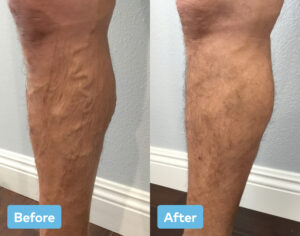Comprehensive Guide to Compression Stockings: Your Solution for Venous Insufficiency and Varicose Veins

Medically Reviewed by Dr. Adam Isadore, MD.
Vascular and Interventional Radiologist, Oceana Vein Specialists.
Comprehensive Guide to Compression Stockings: Your Solution for Venous Insufficiency and Varicose Veins
Welcome to Oceana Vein Specialists, located at 2125 S El Camino Real #210, Oceanside, CA 92054. Dr. Adam Isadore and our dedicated team are committed to providing expert guidance and the latest treatments for venous insufficiency and varicose veins. Compression stockings are a vital tool in improving your vascular health and overall well-being. In this comprehensive guide, we’ll explore the benefits of compression stockings, including their materials, lengths, styles, and how to achieve the perfect fit. By the end, you’ll have the knowledge you need to make informed decisions for your vascular health.
For more information or to schedule a consultation, you can reach us at 760-231-1165
Understanding Venous Insufficiency and Varicose Veins
Before diving into compression stockings, let’s briefly touch on the conditions they help address:
- Venous Insufficiency: This occurs when leg veins fail to efficiently return blood to the heart, resulting in blood pooling in the lower extremities. Symptoms include swelling, pain, and skin changes. For a deeper look into venous insufficiency and its symptoms, check out our dedicated page.
- Varicose Veins: Enlarged, twisted veins usually appearing in the legs due to weakened vein walls and malfunctioning valves, causing blood accumulation, discomfort, and visible bulging. Learn more about varicose veins and treatment options on our vein education page.
Benefits of Compression Stockings
Compression stockings (also known as compression socks or support hose) provide numerous benefits, greatly enhancing vascular health. Let’s explore why they are such a valuable tool:
1. Improved Blood Circulation
Compression stockings help promote blood flow from the legs back to the heart by applying graduated pressure, with the greatest pressure at the ankle. This process aids venous return, supports valve function, and prevents blood from pooling in the veins. Compression therapy is a core part of conservative therapy used to manage venous insufficiency.
2. Reduction of Swelling
Swelling (edema) is a common symptom of venous insufficiency. Compression stockings redistribute excess fluid, reducing swelling and restoring natural leg shape, allowing for more comfortable movement.
3. Pain Relief
Compression stockings evenly distribute pressure across the legs, alleviating pain and reducing muscle fatigue, particularly during long periods of standing or walking. This can be an excellent addition to various other vein treatments for those dealing with discomfort caused by varicose or spider veins.
4. Prevention of Blood Clots
Compression stockings reduce the risk of deep vein thrombosis (DVT) by improving blood flow, making them essential for individuals at higher risk, such as those recovering from surgery or taking long flights. Preventative measures like these are often recommended before exploring advanced treatments like varicose vein treatment or spider vein treatment.
Materials and Types of Compression Stockings
Compression stockings come in a variety of materials and types. The most common are graduated compression stockings, which apply the most pressure at the ankle and decrease up the leg. Stockings are available in different compression levels:
- Mild Compression (8-15 mmHg): Ideal for occasional leg discomfort.
- Moderate Compression (15-20 mmHg): Relieves symptoms of mild venous insufficiency, swelling, and varicose veins.
- Firm Compression (20-30 mmHg): Recommended for more advanced conditions such as chronic venous insufficiency and preventing DVT.
- Extra-Firm Compression (30-40 mmHg): Reserved for severe venous disorders under medical supervision.
Lengths and Styles of Compression Stockings
Compression stockings come in various lengths and styles to cater to individual needs:
- Knee-High Stockings: Best for mild to moderate vein conditions.
- Thigh-High Stockings: For more severe conditions affecting the upper leg.
- Pantyhose/Maternity Stockings: Provide compression to legs and abdomen, ideal during pregnancy.
Achieving the Perfect Fit
For compression stockings to work effectively, they must fit properly. Here’s how:
- Consultation: Dr. Adam Isadore will assess your condition and recommend the most suitable stockings for your needs.
- Accurate Measurements: Measurements are taken at key points on the leg to ensure the optimal fit.
- Donning and Doffing: Proper techniques for putting on and removing compression stockings will be taught to avoid wrinkles or folds that may impede circulation.
The Role of Compression Stockings in Venous Health
Compression stockings are often the first line of defense against venous insufficiency and varicose veins. They complement other treatments such as Radiofrequency Ablation (RFA), Sclerotherapy, and Lifestyle Modifications (exercise, weight management). For more information on how these conservative measures can complement other treatment options, visit our treatments page.
Take the First Step Towards Healthier Legs Today!
Compression stockings are an essential tool in managing venous insufficiency, varicose veins, and preventing complications like DVT. If you’re experiencing symptoms or want to improve your vascular health, schedule a consultation with Dr. Adam Isadore at Oceana Vein Specialists, located at 2125 S El Camino Real #210, Oceanside, CA 92054.
Request an Appointment
Fill out the form below and we will get back to you today to schedule your appointment.




